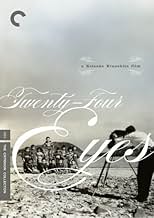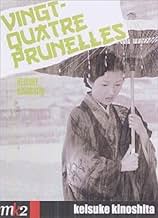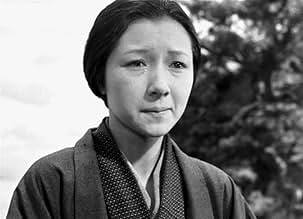CALIFICACIÓN DE IMDb
8.0/10
3.1 k
TU CALIFICACIÓN
La maestra Hisako Oishi crea un vínculo emocional con sus alumnos y les enseña diversas virtudes, al tiempo que se preocupa por su futuro.La maestra Hisako Oishi crea un vínculo emocional con sus alumnos y les enseña diversas virtudes, al tiempo que se preocupa por su futuro.La maestra Hisako Oishi crea un vínculo emocional con sus alumnos y les enseña diversas virtudes, al tiempo que se preocupa por su futuro.
- Dirección
- Guionistas
- Elenco
- Premios
- 10 premios ganados y 1 nominación en total
- Dirección
- Guionistas
- Todo el elenco y el equipo
- Producción, taquilla y más en IMDbPro
Opiniones destacadas
"Years might go by, but the mountain colour never change."
This movie is an excellent work of art by Keisuke Kinoshita.
It starts off with a new teacher being assigned to teach the first grade in a poor village. She is initially rejected from the community, and is gossiped about constantly. However the students she teaches fall in love with her style. One of her tasks is to teach the children to sing. However, instead of teaching school songs or patriotic songs, she teaches them folk songs. Misfortune strikes and she is forced to leave the school, but not before she makes a lasting impression on the children. They will see her again, as a teacher, but not for another five years.
From these humble beginnings a rich story about the poor in Japan before, during, and after World War 2 is shown. We get to know all twelve children ("24 eyes") in the movie, and eventually learn about their fates as adults. We see the equivalent of the "Red Scare" in Japan, and the saddening events caused by World War 2. Although overdramatic, the feelings still feel genuine and even the hardest of people will not be able to resist shedding a tear or two over the fates of the children you grow to love.
I can only ask you to watch the full 3 hours. That is the only way one can truly appreciate the beauty of this film. There is nothing else to be said.
This movie is an excellent work of art by Keisuke Kinoshita.
It starts off with a new teacher being assigned to teach the first grade in a poor village. She is initially rejected from the community, and is gossiped about constantly. However the students she teaches fall in love with her style. One of her tasks is to teach the children to sing. However, instead of teaching school songs or patriotic songs, she teaches them folk songs. Misfortune strikes and she is forced to leave the school, but not before she makes a lasting impression on the children. They will see her again, as a teacher, but not for another five years.
From these humble beginnings a rich story about the poor in Japan before, during, and after World War 2 is shown. We get to know all twelve children ("24 eyes") in the movie, and eventually learn about their fates as adults. We see the equivalent of the "Red Scare" in Japan, and the saddening events caused by World War 2. Although overdramatic, the feelings still feel genuine and even the hardest of people will not be able to resist shedding a tear or two over the fates of the children you grow to love.
I can only ask you to watch the full 3 hours. That is the only way one can truly appreciate the beauty of this film. There is nothing else to be said.
It was a pleasure for me to see this lovely movie, a film I've really wished to see in the last four years but I couldn't do it until today. I heard about this movie when I lived in Japan and visited Shodoshima island, where "Eiga Mura" (Cinema Village), the place this film was made, can still be visited and the atmosphere of the past can be enjoyed. To be honest, I must say that "Nijushi no hitomi" wasn't for me the "exceptional film" I expected to see, but anyway it has been a pleasant experience. The life of the rural teacher, from the start of her career (in the mid 20's) to the time she retakes her teaching position after having become a widow (in the 40's, after the end of WWII), is an interesting guide to discover the traditional life and mentalities in the small islands of Seto (Japan Inland Sea). A good point for this film: it is usually said that this is an "anti-war" film. Well, it is true that the teacher shows a clear position against the wars Japan was involved (the war against China and the later Pacific War against the USA), but this film mustn't be considered as a pacifist pamphlet: the honest position of the teacher against the war is just one more detail in this complete description of how life should be in rural Japan during those difficult prewar, war and postwar years. A film that should be shown in every school around the world.
People who view this film would do well to consider the sentiment of post-war Japan in the mid-50s, when the future was still uncertain and the vast devastation and shame caused by the war were prevalent in the mindset of its citizens.
The timing for this film's release was significant, because perhaps for the first time, it permitted the people of Japan to cry unabashedly for themselves, far removed from any political statement so frequent in Shochiku films such as with many of Kurosawa's classics. Movies at the time tended to have positive, uplifting themes that motivated the populous to help rebuild the country into a modern democratic nation. You can thank Douglas MacArthur for that.
The post-war generation was now almost 10 years old, and in the Japanese psyche was the need for justification for its darkest period in history.
This film served as a reminder of the horrors of war, not from the battlefields, but from the emotional scars left on its children who lived and died during it.
Hideko Takamine brilliantly played the role of a school teacher on a typical remote island community in south Japan during an increasingly militarist government. As was customary at the time, the same teacher saw to their students' education from primary to high school, forming a lifetime bond.
Director Keisuke Kinoshita's camera work is nothing less than genius, beautifully portraying the transitions of seasons from year to year. The water, sand, and dust textures are so distinct that you almost forget that it was filmed in black and white.
The character closeups are never exaggerated and the 12 children actors (hence "24 Eyes") do an outstanding job portraying how they end up sacrificing their childhood dreams due to poverty and for national duty.
Of symbolic note is the appearance of the Island bus, which is seen at first with Japanese kanji characters painted on the side. Later in the film, it's written in English as "Shima Bus", signifying how modernization has reached the island after the war.
From cast, location and cinematography, Nijushi no Hitomi is a masterpiece of emotional storytelling.
The timing for this film's release was significant, because perhaps for the first time, it permitted the people of Japan to cry unabashedly for themselves, far removed from any political statement so frequent in Shochiku films such as with many of Kurosawa's classics. Movies at the time tended to have positive, uplifting themes that motivated the populous to help rebuild the country into a modern democratic nation. You can thank Douglas MacArthur for that.
The post-war generation was now almost 10 years old, and in the Japanese psyche was the need for justification for its darkest period in history.
This film served as a reminder of the horrors of war, not from the battlefields, but from the emotional scars left on its children who lived and died during it.
Hideko Takamine brilliantly played the role of a school teacher on a typical remote island community in south Japan during an increasingly militarist government. As was customary at the time, the same teacher saw to their students' education from primary to high school, forming a lifetime bond.
Director Keisuke Kinoshita's camera work is nothing less than genius, beautifully portraying the transitions of seasons from year to year. The water, sand, and dust textures are so distinct that you almost forget that it was filmed in black and white.
The character closeups are never exaggerated and the 12 children actors (hence "24 Eyes") do an outstanding job portraying how they end up sacrificing their childhood dreams due to poverty and for national duty.
Of symbolic note is the appearance of the Island bus, which is seen at first with Japanese kanji characters painted on the side. Later in the film, it's written in English as "Shima Bus", signifying how modernization has reached the island after the war.
From cast, location and cinematography, Nijushi no Hitomi is a masterpiece of emotional storytelling.
Considered by some Japanese critics as one of the ten best Japanese films of all time, Keisuke Kinoshita's Twenty-Four Eyes is a moving tribute to a teacher's dedication to her students and to her progressive ideals. The film spans twenty years of turbulent Japanese history beginning in 1928 and continuing through the end of World War II. Though to Western eyes it can be at times oppressively melodramatic with its overuse of such sentimental melodies like "Annie Laurie", "Auld Lang Syne", and "Bless This House", the film was extremely popular in Japan, beating out such highly regarded classics as Mizoguchi's Sansho Dayu, Kurosawa's Seven Samurai, and Naruse's Late Chrysanthemums for Best Film in Japan and Best Foreign Film at the Golden Globes.
Adapted from a novel by Sakae Tsuboi and set in the rural island of Shodoshima, the title refers to the eyes of seven girls and five boys, the twelve students of first grade teacher Hisako Oishi (Hideko Takamine), endearingly called "Miss Pebble". As the film opens, a confident new teacher, Miss Oishi, rides to the school on her bicycle dressed in modern Western clothes but soon has problems being accepted by the working class villagers who think that she is a wealthy outsider. The senior teacher (Chishu Ryu) at the primary school even asks why the authorities would send such a good teacher. Miss Oishi is also criticized for calling the students by their nicknames, inquiring into each child's family life, and singing folk songs instead of the school anthems.
Later, during the Japanese invasion of China, she is suspected of being a "red" because she discourages her young pupils from becoming soldiers but does not protest when the headmaster burns one of her books. Proud but traditionally passive, she refuses to intervene in a family dispute when one of her students, a gifted singer, expresses a desire to attend the conservatory rather than go to work in a café, and does not attempt to raise funds to send one of the poorest students on a school trip. Miss Oishi is able to gain a share of acceptance, however, after an injury to her leg sidelines her for several months and the children visit her without being aware of the length of the journey. It is only when she meets the crying children on their way to her home that reconciliation with the community begins to take place.
Unfortunately, the length of the trip to the school forces Miss Oishi to transfer to the middle school closer to her home and she will not teach the same children for five years. Miss Oishi is a compassionate teacher who does not want to see her bright young students killed in the war but the growing conflict in China and the increasing poverty in the village force the young men to become cannon fodder for the militarists with unfortunate results. Twenty-Four Eyes to our modern view has many excesses including its almost three-hour length but the purity and radiance of Takamine as the compassionate school teacher shines through and the film allowed Japanese audiences to experience a cathartic expression of the sadness and loss caused by the war.
Adapted from a novel by Sakae Tsuboi and set in the rural island of Shodoshima, the title refers to the eyes of seven girls and five boys, the twelve students of first grade teacher Hisako Oishi (Hideko Takamine), endearingly called "Miss Pebble". As the film opens, a confident new teacher, Miss Oishi, rides to the school on her bicycle dressed in modern Western clothes but soon has problems being accepted by the working class villagers who think that she is a wealthy outsider. The senior teacher (Chishu Ryu) at the primary school even asks why the authorities would send such a good teacher. Miss Oishi is also criticized for calling the students by their nicknames, inquiring into each child's family life, and singing folk songs instead of the school anthems.
Later, during the Japanese invasion of China, she is suspected of being a "red" because she discourages her young pupils from becoming soldiers but does not protest when the headmaster burns one of her books. Proud but traditionally passive, she refuses to intervene in a family dispute when one of her students, a gifted singer, expresses a desire to attend the conservatory rather than go to work in a café, and does not attempt to raise funds to send one of the poorest students on a school trip. Miss Oishi is able to gain a share of acceptance, however, after an injury to her leg sidelines her for several months and the children visit her without being aware of the length of the journey. It is only when she meets the crying children on their way to her home that reconciliation with the community begins to take place.
Unfortunately, the length of the trip to the school forces Miss Oishi to transfer to the middle school closer to her home and she will not teach the same children for five years. Miss Oishi is a compassionate teacher who does not want to see her bright young students killed in the war but the growing conflict in China and the increasing poverty in the village force the young men to become cannon fodder for the militarists with unfortunate results. Twenty-Four Eyes to our modern view has many excesses including its almost three-hour length but the purity and radiance of Takamine as the compassionate school teacher shines through and the film allowed Japanese audiences to experience a cathartic expression of the sadness and loss caused by the war.
25 years ago I made up my mind I would move to Japan. So I wrote to people in Japan who had lived there for over thirty years, and asked them what would be the #1 movie I should watch that encapsulated the spirit of the Japanese.
They all suggested "24 Eyes".
Now, after having lived in a strictly Japanese environment for five years, and having seen well over thirty Japanese movies, not to mention over a thousand hours of TV shows and animae, it is still the #1 to me.
By today's standards it will seem extremely "G" rated, a little too slow and a bit too long. But for those who want to really understand people, and where they are coming from, I can't think of a better movie to recommend. I wish every culture, particularly those that may be going extinct, would use this movie as a guideline to tell their story.
They all suggested "24 Eyes".
Now, after having lived in a strictly Japanese environment for five years, and having seen well over thirty Japanese movies, not to mention over a thousand hours of TV shows and animae, it is still the #1 to me.
By today's standards it will seem extremely "G" rated, a little too slow and a bit too long. But for those who want to really understand people, and where they are coming from, I can't think of a better movie to recommend. I wish every culture, particularly those that may be going extinct, would use this movie as a guideline to tell their story.
¿Sabías que…?
- TriviaAccording to Japanese film critic and historian Tadao Satô, in casting this film about a schoolteacher and her relationships with her pupils over many years, director Keisuke Kinoshita very cleverly chose pairs of look-alike siblings to portray the students. So for those scenes set in later years, Kinoshita simply substituted the older siblings for the younger ones, so that the schoolchildren appeared to "grow" before the audience's eyes.
- ConexionesReferenced in Hakuchû no tôrima (1966)
- Bandas sonorasAnnie Laurie
Selecciones populares
Inicia sesión para calificar y agrega a la lista de videos para obtener recomendaciones personalizadas
- How long is Twenty-Four Eyes?Con tecnología de Alexa
Detalles
- Tiempo de ejecución
- 2h 36min(156 min)
- Color
- Mezcla de sonido
- Relación de aspecto
- 1.37 : 1
Contribuir a esta página
Sugiere una edición o agrega el contenido que falta










